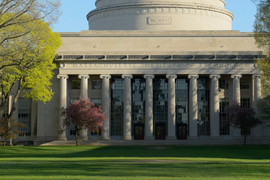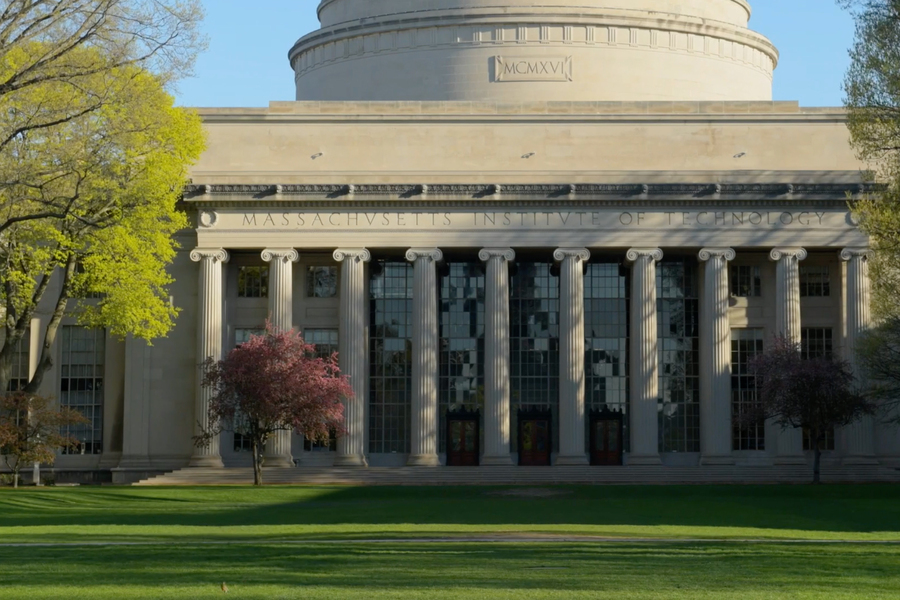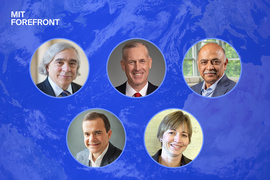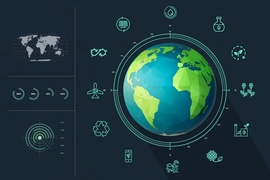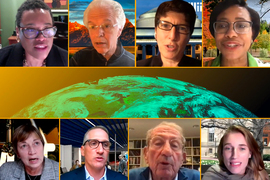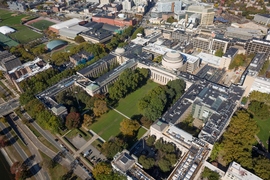MIT has released an ambitious new plan for action to address the world’s accelerating climate crisis. The plan, titled “Fast Forward: MIT’s Climate Action Plan for the Decade,” includes a broad array of new initiatives and significant expansions of existing programs, to address the needs for new technologies, new policies, and new kinds of outreach to bring the Institute’s expertise to bear on this critical global issue.
As MIT President L. Rafael Reif and other senior leaders have written in a letter to the MIT community announcing the new plan, “Humanity must find affordable, equitable ways to bring every sector of the global economy to net-zero carbon emissions no later than 2050.” And in order to do that, “we must go as far as we can, as fast as we can, with the tools and methods we have now.” But that alone, they stress, will not be enough to meet that essential goal. Significant investments will also be needed to invent and deploy new tools, including technological breakthroughs, policy initiatives, and effective strategies for education and communication about this epochal challenge.
“Our approach is to build on what the MIT community does best — and then aspire for still more. Harnessing MIT’s long record as a leader in innovation, the plan’s driving force is a series of initiatives to ignite research on, and accelerate the deployment of, the technologies and policies that will produce the greatest impact on limiting global climate change,” says Vice President for Research Maria Zuber, who led the creation and implementation of MIT’s first climate action plan and oversaw the development of the new plan alongside Associate Provost Richard Lester and School of Engineering Dean Anantha Chandrakasan.
The new plan includes a commitment to investigate the essential dynamics of global warming and its impacts, increasing efforts toward more precise predictions, and advocating for science-based climate policies and increased funding for climate research. It also aims to foster innovation through new research grants, faculty hiring policies, and student fellowship opportunities.
Decarbonizing the world’s economy in time will require “new ideas, transformed into practical solutions, in record time,” the plan states, and so it includes a push for research focused on key areas such as cement and steel production, heavy transportation, and ways to remove carbon from the air. The plan affirms the imperative for decarbonization efforts to emphasize the need for equity and fairness, and for broad outreach to all segments of society.
Charting a shared course for the future
Having made substantial progress in implementing the Institute’s original five-year Plan for Action on Climate Change, MIT’s new plan outlines measures to build upon and expand that progress over the next decade. The plan consists of five broad areas of action: sparking innovation, educating future generations, informing and leveraging government action, reducing MIT’s own climate impact, and uniting and coordinating all of MIT’s climate efforts.
MIT is already well on its way to reaching the initial target, set in 2015, to reduce the Institute’s net carbon emissions by at least 32 percent from 2014 levels by the year 2030. That goal is being met through a combination of innovative off-campus power purchase agreements that enable the construction of large-scale solar and wind farms, and an array of renewable energy and building efficiency measures on campus. In the new plan, MIT commits to net-zero direct carbon emissions by 2026.
The initial plan focused largely on intensifying efforts to find breakthrough solutions for addressing climate change, through a series of actions including the creation of new low-carbon energy centers for research, and the convening of researchers, industry leaders, and policymakers to facilitate the sharing of best practices and successful measures. The new plan expands upon these actions and incorporates new measures, such as climate-focused faculty positions and student work opportunities to help tackle climate issues from a variety of disciplines and perspectives.
A long-running series of symposia, community forums, and other events and discussions helped shape a set of underlying principles that apply to all of the plan’s many component parts. These themes are:
- The centrality of science, to build on MIT’s pioneering work in understanding the dynamics of global warming and its effects;
- The need to innovate and scale, requiring new ideas to be made into practical solutions quickly;
- The imperative of justice, since many of those who will be most affected by climate change are among those with the least resources to adapt;
- The need for engagement, dealing with government, industry, and society as a whole, reflecting the fact that decarbonizing the world’s economy will require working with leaders in all sectors; and
- The power of coordination, emphasizing the need for the many different parts of the Institute’s climate research, education, and outreach to have clear structures for decision making, action, and accountability.
Bolstering research and innovation
The new plan features a wide array of action items to encourage innovation in critical areas, including new programs as well as the expansions of existing programs. This includes the Climate Grand Challenges, announced last year, which focus on game-changing research advances across disciplines spanning MIT.
“We must, and we do, call for critical self-examination of our own footprint, and aspire to substantial reductions. We also must, and we do, renew and bolster our commitment to the kind of paradigm-shifting research and innovation, across every sector and in every field of human endeavor, that the world expects from MIT,” notes Professor Lester. “An existential challenge like climate change calls for both immediate action and extraordinary long shots. I believe the people of MIT are capable of both.”
The plan also calls for expanding the MIT Climate and Sustainability Consortium, created earlier this year, to foster collaborations among companies and researchers to work for solutions to climate problems. The aim is to greatly accelerate the adoption of large-scale, real-world climate solutions, across different industries around the world, by working with large companies as they work to find ways to meet new net-zero climate targets, in areas ranging from aerospace to packaged food.
Another planned action is to establish a Future Energy Systems Center, which will coalesce the work that has been fostered through MIT’s Low-Carbon Energy Centers, created under the previous climate action plan. The Institute is also committing to devoting at least 20 upcoming faculty positions to climate-focused talent. And, there will be new midcareer ignition grants for faculty to spur work related to climate change and clean energy.
For students, the plan will provide up to 100 new Climate and Sustainability Energy Fellowships, spanning the Institute’s five schools and one college. These will enable work on current or new projects related to climate change. There will also be a new Climate Education Task Force to evaluate current offerings and make recommendations for strengthening research on climate-related topics. And, in-depth climate or clean-energy-related research opportunities will be offered to every undergraduate who wants one. Climate and sustainability topics and examples will be introduced into courses throughout the Institute, especially in the General Institute Requirements that all undergraduates must take.
This emphasis on MIT’s students is reflected in the plan’s introductory cover letter from Reif, Zuber, Lester, Chandrakasan, and Executive Vice President and Treasurer Glen Shor. They write: “In facing this challenge, we have very high expectations for our students; we expect them to help make the impossible possible. And we owe it to them to face this crisis by coming together in a whole-of-MIT effort — deliberately, wholeheartedly, and as fast as we can.”
The plan’s educational components provide “the opportunity to fundamentally change how we have our graduates think in terms of a sustainable future,” Chandrakasan says. “I think the opportunity to embed this notion of sustainability into every class, to think about design for sustainability, is a very important aspect of what we’re doing. And, this plan could significantly increase the faculty focused on this critical area in the next several years. The potential impact of that is tremendous.”
Reaching outward
The plan calls for creating a new Sustainability Policy Hub for undergraduates and graduate students to foster interactions with sustainability policymakers and faculty, including facilitating climate policy internships in Washington. There will be an expansion of the Council on the Uncertain Human Future, which started last year to bring together various groups to consider the climate crisis and its impacts on how people might live now and in the future.
“The proposed new Sustainability Policy Hub, coordinated by the Technology and Policy Program, will help MIT students and researchers engage with decision makers on topics that directly affect people and their well-being today and in the future,” says Noelle Selin, an associate professor in the Institute for Data, Systems, and Society and the Department of Earth, Atmospheric, and Planetary Sciences. “Ensuring sustainability in a changed climate is a collaborative effort, and working with policymakers and communities will be critical to ensure our research leads to action.”
A new series of Climate Action Symposia, similar to a successful series held in 2019-2020, will be convened. These events may include a focus on climate challenges for the developing world. In addition, MIT will develop a science- and fact-based curriculum on climate issues for high school students. These will be aimed at underserved populations and at countering sources of misinformation.
Building on its ongoing efforts to provide reliable, evidence-based information on climate science, technology, and policy solutions to policymakers at all levels of government, MIT is establishing a faculty-led Climate Policy Working Group, which will work with the Institute’s Washington office to help connect faculty members doing relevant research with officials working in those areas.
In the financial arena, MIT will lead more research and discussions aimed at strengthening the financial disclosures relating to climate that corporations need to make, thus making the markets more sensitive to the true risks to investors posed by climate change. In addition, MIT will develop a series of case studies of companies that have made a conversion to decarbonized energy and to sustainable practices, in order to provide useful models for others.
MIT will also expand the reach of its tools for modeling the impacts of various policy decisions on climate outcomes, economics, and energy systems. And, it will continue to send delegations to the major climate policy forums such as the UN’s Conference of the Parties, and to find new audiences for its Climate Portal, web-based Climate Primer, and TILclimate podcast.
“This plan reaffirms MIT’s commitment to developing climate change solutions,” says Christopher Knittel, the George P. Shultz Professor of Applied Economics. “It understands that solving climate change will require not only new technologies but also new climate leaders and new policy. The plan leverages MIT’s strength across all three of these, as well as its most prized resources: its students. I look forward to working with our students and policymakers in using the tools of economics to provide the research needed for evidence-based policymaking.”
Recognizing that the impacts of climate change fall most heavily on some populations that have contributed little to the problem but have limited means to make the needed changes, the plan emphasizes the importance of addressing the socioeconomic challenges posed by major transitions in energy systems, and will focus on job creation and community support in these regions, both domestically and in the developing world. These programs include the Environmental Solutions Initiative’s Natural Climate Solutions Program, and the Climate Resilience Early Warning System Network, which aims to provide fine-grained climate predictions.
“I’m extraordinarily excited about the plan,” says Professor John Fernández, director of the Environmental Solutions Initiative and a professor of building technology. “These are exactly the right things for MIT to be doing, and they align well with an increasing appetite across our community. We have extensive expertise at MIT to contribute to diverse solutions, but our reach should be expanded and I think this plan will help us do that.”
“It’s so encouraging to see environmental justice issues and community collaborations centered in the new climate action plan,” says Amy Moran-Thomas, the Alfred Henry and Jean Morrison Hayes Career Development Associate Professor of Anthropology. “This is a vital step forward. MIT’s policy responses and climate technology design can be so much more significant in their reach with these engagements done in a meaningful way.”
Decarbonizing campus
MIT’s first climate action plan produced mechanisms and actions that have led to significant reductions in net emissions. For example, through an innovative collaborative power purchase agreement, MIT enabled the construction of a large solar farm and the early retirement of a coal plant, and also provided a model that others have since adopted. Because of the existing agreement, MIT has already reduced its net emissions by 24 percent despite a boom in construction of new buildings on campus. This model will be extended moving forward, as MIT explores a variety of possible large-scale collaborative agreements to enable solar energy, wind energy, energy storage, and other emissions-curbing facilities.
Using the campus as a living testbed, the Institute has studied every aspect of its operations to assess their climate impacts, including heating and cooling, electricity, lighting, materials, and transportation. The studies confirm the difficulties inherent in transforming large existing infrastructure, but all feasible reductions in emissions are being pursued. Among them: All new purchases of light vehicles will be zero-emissions if available. The amount of solar generation on campus will increase fivefold, from 100 to 500 kilowatts. Shuttle buses will begin converting to electric power no later than 2026, and the number of car-charging stations will triple, to 360.
Meanwhile, a new working group will study possibilities for further reductions of on-campus emissions, including indirect emissions encompassed in the UN’s Scope 3 category, such as embedded energy in construction materials, as well as possible measures to offset off-campus Institute-sponsored travel. The group will also study goals relating to food, water, and waste systems; develop a campus climate resilience plan; and expand the accounting of greenhouse gas emissions to include MIT’s facilities outside the campus. It will encourage all labs, departments, and centers to develop plans for sustainability and reductions in emissions.
“This is a broad and appropriately ambitious plan that reflects the headway we’ve made building up capacity over the last five years,” says Robert Armstrong, director of the MIT Energy Initiative. “To succeed we’ll need to continually integrate new understanding of climate science, science and technology innovations, and societal engagement from the many elements of this plan, and to be agile in adapting ongoing work accordingly.”
Examining investments
To help bring MIT’s investments in line with these climate goals, MIT has already begun the process of decarbonizing its portfolio, but aims to go further.
Beyond merely declaring an aspirational goal for such reductions, the Institute will take this on as a serious research question, by undertaking an intensive analysis of what it would mean to achieve net-zero carbon by 2050 in a broad investment portfolio.
“I am grateful to MITIMCO for their seriousness in affirming this step,” Zuber says. “We hope the outcome of this analysis will help not just our institution but possibly other institutional managers with a broad portfolio who aspire to a net-zero carbon goal.”
MIT’s investment management company will also review its environmental, social, and governance investment framework and post it online. And, as a member of Climate Action 100+, MIT will be actively engaging with major companies about their climate-change planning. For the planned development of the Volpe site in Kendall square, MIT will offset the entire carbon footprint and raise the site above the projected 2070 100-year flood level.
Institute-wide participation
A centerpiece of the new plan is the creation of two high-level committees representing all parts of the MIT community. The MIT Climate Steering Committee, a council of faculty and administrative leaders, will oversee and coordinate MIT’s strategies on climate change, from technology to policy. The steering committee will serve as an “orchestra conductor,” coordinating with the heads of the various climate-related departments, labs, and centers, as well as issue-focused working groups, seeking input from across the Institute, setting priorities, committing resources, and communicating regularly on the progress of the climate plan’s implementation.
The second committee, called the Climate Nucleus, will include representatives of climate- and energy-focused departments, labs, and centers that have significant responsibilities under the climate plan. It will have broad responsibility for overseeing the management and implementation of all elements of the plan, including program planning, budgeting and staffing, fundraising, external and internal engagement, and program-level accountability. The Nucleus will make recommendations to the Climate Steering Committee on a regular basis and report annually to the steering committee on progress under the plan.
“We heard loud and clear that MIT needed both a representative voice for all those pursuing research, education, and innovation to achieve our climate and sustainability goals, but also a body that’s nimble enough to move quickly and imbued with enough budgetary oversight and leadership authority to act decisively. With the Climate Steering Committee and Climate Nucleus together, we hope to do both,” Lester says.
The new plan also calls for the creation of three working groups to address specific aspects of climate action. The working groups will include faculty, staff, students, and alumni and give these groups direct input into the ongoing implementation of MIT’s plans. The three groups will focus on climate education, climate policy, and MIT’s own carbon footprint. They will track progress under the plan and make recommendations to the Nucleus on ways of increasing MIT’s effectiveness and impact.
“MIT is in an extraordinary position to make a difference and to set a standard of climate leadership,” the plan’s cover letter says. “With this plan, we commit to a coordinated set of leadership actions to spur innovation, accelerate action, and deliver practical impact.”
“Successfully addressing the challenges posed by climate change will require breakthrough science, daring innovation, and practical solutions, the very trifecta that defines MIT research,” says Raffaele Ferrari, the Cecil and Ida Green Professor of Oceanography. “The MIT climate action plan lays out a comprehensive vision to bring the whole Institute together and address these challenges head on. “Last century, MIT helped put humans on the moon. This century, it is committing to help save humanity and the environment from climate change here on Earth.”
